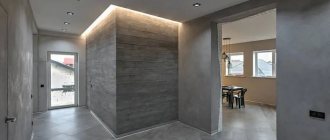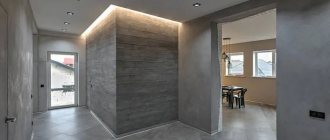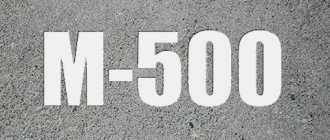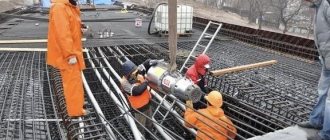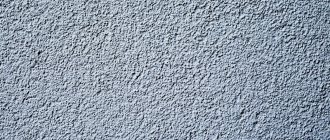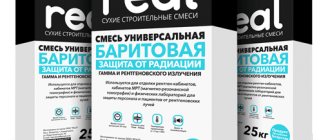Today, an original and inexpensive method of finishing facades and internal wall surfaces is popular - decorative plaster to look like concrete. The finished plaster mixture differs from the usual one: it contains small pebbles and large grains of sand, which shimmer in the rays of light and reflect with a pearlescent sheen.
There are mixtures of different shades on sale: gray, beige, blue, yellowish, light brown, light green, and others. You can independently give gray concrete-look plaster the desired shade by adding a little acrylic paint to it.
Advantages of decorative plaster for concrete applied by yourself.
Correct application, skillfully and moderately demonstrated imagination, compatibility with other elements of the structure are the key to the fact that the plaster will look no worse than expensive tiles. This coating has other advantages:
Small time investment. In a few days, you can treat all external walls alone.- The ability to obtain a surface with different effects: smooth, textured, patterned, rough, plain, multi-colored or speckled.
- Wide selection of plaster compositions.
- Heat saving ability. Saving space heating costs – 25%.
- Resistance to destruction under the influence of dampness, high and low temperatures.
- Possibility to use other types of finishing: concrete plaster can be painted and varnished.
Why is there a need to paint concrete?
Staining concrete surfaces helps accomplish several tasks. Additional processing increases the comfort of staying in the room, promotes dust removal and protection, ensuring a long maintenance-free service life.
If we talk about functionality, the surface becomes resistant to mechanical damage, wear, and the action of aggressive and chemical substances . If concrete is used outdoors, coloring blocks the negative effects of moisture, temperature changes, and sun.
Decorative paints, in addition to protecting concrete, also solve aesthetic issues
Features of working with the finished mixture.
Decorative plaster for concrete does not have a solid, but a porous structure. Cover the wall in several layers. This achieves the effect of a relief and volumetric surface. There are more than 10 application options in total, but we will consider only the most popular ones.
Tip: Translucent plaster will help create an impressive effect. This wall looks especially interesting with decorative lighting.
A noble coating will be obtained if you use a composition interspersed with golden color. A gilded concrete wall is unexpected and stylish. There are mixtures with other effects: rust, wear, silver, bronze, concrete with efflorescence, art concrete, etc. Inexpensive concrete plaster is mainly available in gray, but you can add a coloring pigment to get the desired shade. If you are going to experiment with colors, keep in mind that you will need a tinting machine.
Selection of paint and varnish material
Previously, it was easier to choose paint, since the assortment was scarce. There are many paints on store shelves today, but not all of them can be used on concrete. It all depends on the operating conditions. Having considered the features, advantages and disadvantages, you can choose what to paint your concrete floor, ceiling or walls.
Oil-based paints and varnishes
The products are made on an oil base. It has long been used for painting interior and exterior surfaces. However, due to the toxic composition due to solvents, it is better not to use it inside. Has a pungent odor. Advantages:
- Affordable price.
- Withstands the negative impact of the street, is not afraid of moisture and other atmospheric factors.
- A durable and beautiful coating is created.
- Oil-based paint can be susceptible to dust and dirt, but it is easy to clean with gentle products.
- Long service life.
- Good adhesion.
- Large selection of colors.
Flaws:
- Strong smell. Requires waiting for weathering before moving in.
- Toxicity.
- Long drying time, 24 hours or more.
- Has low elasticity, if the concrete cracks, the paint will tear.
- The color is unstable. The drying oil will turn yellow as it is used.
To conclude, oil paint for concrete walls is good if you need to repaint a storage area or other exterior surfaces. After all, it is cheap and practical. But it is better not to use it for work around the house or garage.
Water based paint
Water emulsion and dispersion are an excellent option for interior painting. It is water-based, so it has many advantages. There are no harmful substances in the composition. It can be used to paint concrete walls, ceilings and interior floors. There are façade paints for exterior use. The packaging indicates for what purposes the composition can be used.
Advantages:
- Environmentally friendly.
- Not afraid of moisture.
- Dries quickly.
- Has no smell.
- Easy to use.
- Paints can be sold in white and tinted by hand.
As for the disadvantages, the only thing we can note is the cost. It is low, but oil formulations are cheaper.
Acrylic paint
A universal option, it can be used to paint concrete ceilings, floors, walls inside and outside. It is based on acrylates, which give the composition special properties. The packaging indicates for what purposes it is used: “Ceiling”, “Facade”, “For walls”. Acrylic compositions are also used for artistic painting.
Advantages:
- Environmentally friendly.
- Not afraid of mechanical impact.
- Elastic.
- Vapor permeable, the walls will breathe without condensation.
- Has a stable color throughout its entire service life.
- Possibility of tinting.
- Long service life.
- Not afraid of moisture.
The downside is the cost. It is high. But if you consider the benefits, the price is justified. When choosing what to paint a concrete wall with, you can safely buy alkyd compounds.
Silicate based
It is also called glass paint, as it is based on liquid glass. Thanks to this, a durable film is created on the surface after painting, protecting the structure of the concrete surface. Suitable for indoor and outdoor surfaces.
Important! To find out the consumption of facade paint per 1m2, you need to look at the packaging. There are specific numbers there.
Advantages of silicate paints:
- Not afraid of chemical exposure.
- Has stable color.
- Strong and durable.
- Protected from fire.
- Not afraid of moisture.
- Resistant to biological factors (development of mold and other microorganisms).
- Very wear-resistant.
Their disadvantages are that they are expensive and contain toxic substances, so when working with them, it is important to take care of respiratory protection.
Advice! There is a rubber-based paint specifically for concrete surfaces. It is often used to paint concrete floors, as it creates a soft coating on the surface. It is elastic and not afraid of small cracks. She also perfectly tolerates all negative influences.
Impregnations for concrete
Painting walls requires preparation. Before the process, it is better to coat the surface with a special impregnation. This will preserve the surface from dirt, moisture and aggressive environments. The impregnation will penetrate the concrete structure and strengthen it. The compositions are made on an acrylic base, polyurethane or epoxy resins. In addition, preliminary application will reduce paint consumption. After all, concrete has a porous structure and absorbs liquids well.
After applying the impregnation, the wall will dry in a few hours (exact time on the packaging). After this, the wall, floor or ceiling will be ready for painting. The impregnation itself is transparent and may also have additional properties, for example, antiseptic. Having considered the features of paints, you can choose what to paint your concrete floor with.
Manufacturers of plaster mixtures.
Here are some of the companies worth considering:
- The products of the Russian company Prof Decor include a variety of plaster for interiors in loft, minimalism, and hi-tech styles.
- ]San Marco[/anchor] produces decorative plaster mixtures based on polymers. Such coatings are strong, durable, moisture resistant, and are well suited for finishing curved surfaces.
- Krasnodar produces textured Hi-teck concrete compositions with good heat-saving ability. The mixtures contain inclusions to create different effects.
- Flex Beton System products are plaster intended for surfaces exposed to heat or in contact with moisture.
Operating procedure.
First you need to remove the old coating from the wall. The existing plaster, which does not hold firmly and has already begun to crumble, can be cleaned off with a spatula, after first moistening the wall with water. Allow the water to soak into the plaster layer to soften it, after which the coating will easily come off if scraped. Particular care must be taken to remove any remaining plaster from cavities and joints.
If the wall was covered with wallpaper, they are removed in the same way. It is more difficult to remove old paint, but this job can be done. Buy a special compound that dissolves old paint at a hardware store or market. One small jar is enough for several square meters.
Important: the composition is toxic, so use gloves, a respirator and work in a well-ventilated area.
Safety precautions
Before starting work, personnel are instructed on safety precautions and working with paints and varnishes and equipment. It is mandatory to use personal protective equipment - overalls, goggles, respirators, rubber gloves.
If concrete painting will be carried out at height, the reliability of hanging cradles and scaffolding should be checked before work. Overloading structures in order to quickly complete work is unacceptable. If workers rise to a height of more than 6 m, a protective flooring is installed on the ground . The area where painting is carried out is fenced off.
In case of electric shock, injury, or contact of solutions with mucous membranes, consult a doctor immediately.
Primer.
A dry wall, cleared of plaster, wallpaper or paint, must be primed. Thanks to this simple procedure, finished concrete plaster with your own hands will look as if it was applied by a professional. The primer ensures good adhesion of the mixture to the surface, and the antiseptic also protects the material from the appearance of mold and mildew.
Tip: if there are traces of mold on the wall, treat it with an antibacterial compound.
Use the primer composition without dilution, unless otherwise specified in the instructions. When diluting with water, make sure that the consistency is uniform. Apply primer with a wide brush. A foam roller is not so convenient because the primer drips off a lot (from the brush too, but less). Apply the first coat, wait until it dries, then coat again. The second time the primer will apply better than the first time.
Application of pseudo-concrete.
The primed wall is covered with a substrate - a mixture of paint and sand. Do-it-yourself decorative concrete-like plaster is applied to such a “cushion” better and more evenly. Subsequently, it holds more firmly, does not crack, or deform. It is better to buy the composition ready-made, as it is made from special paint and some components are added to impart antibacterial properties and improve adhesion.
Think in advance what kind of surface texture you want to get. Application Tools:
- spatulas of different widths;
- Master OK;
- brush;
- wand.
To create a complex relief, a roller covered with a metal mesh is useful. You can use other devices, depending on your idea. Exactly how to apply should be written on the packaging of decorative concrete plaster. There is one general rule: the more complex the pattern, the thinner the layers and the greater their number.
Tools, equipment, protective equipment
For most types of decorative paints, a typical set of tools is required - rollers, brushes, spray guns, spatulas. Brushes can be different - from horsehair, bristles, synthetic fibers. Optimal technological parameters are inherent in tools based on animal hair. However, they are not very durable and quickly lose their elasticity.
The compromise is to use brushes made of bristles and horsehair. If we talk about synthetic analogues, they shade the material on concrete worse, hold it worse and take away the paint. Regardless of the type of tool, after work it is thoroughly washed (with water or solvent) , which will significantly extend its service life.
To apply decorative paints to concrete you will need:
- swing round brush – used to cover large surfaces (walls, ceilings). It is better to choose a tool with a long handle;
- flat flute brushes, paneled brushes - for processing junctions and hard-to-reach areas;
- rectangular trimming brush - used for the finishing layer, helps to obtain a rough texture;
- paint rollers are smooth, with medium, high pile - it is optimal to take equipment made of siege or foam rubber. A more productive option compared to brushes;
- hard metal brushes, scrapers, spatulas - required at the preparation stage;
- spray guns – devices for mechanized application of compositions that provide maximum productivity;
- telescopic handles;
- mixing containers;
- painting trays;
- sprayers;
- plaster trowel;
- devices for cleaning concrete under high pressure;
- protective tape (for doors, windows);
- tarpaulin for flooring, painting net;
- sealant gun;
- hanging cradles, scaffolding, ladders.
Don’t forget about protective uniforms - overalls, rubber gloves, goggles, respirators
Popular application methods.
- Using a broom is a simple and affordable option that does not require special skills. Dip the edge of the broom into the prepared mixture and spray it on the wall, hitting the rods with some object. The result is an original, beautiful coating.
- If the previous method seems too simple, try shading. Use a wire brush to brush over the surface: it will look like a graphic design. Choose the direction of the strokes experimentally.
- Using ready-made stencils. The method will be useful for those who are afraid that they will not be able to beautifully apply plaster under concrete. Stencils make the task easier: with them the given design is obtained by itself.
- Mixing plaster of different colors. Do you consider yourself an experienced craftsman? Then this option is right for you.
Advice: if you have not dealt with decorative plaster for concrete before, first take a piece of plywood or fiberboard and try working on it. When you are sure that the material “listens” to you, start plastering the wall.
The setting time for concrete plaster is approximately 20 minutes, with possible deviation in one direction or another. After this time, smooth the surface with a trowel. After an hour, touch up with sandpaper. This will allow you to achieve a more accurate and expressive drawing. Complete drying will occur after 24 hours.
Watch the video that shows how to properly apply decorative plaster under concrete:
Using plaster in the Loft style
Returning to everyone’s favorite loft: it’s hard to imagine it without concrete surfaces. However, it is very important not to overdo it. In typical “loft” rooms with huge windows and high ceilings, this is not a problem; in other cases, think about the lighting and choose lighter shades of gray.
For small rooms you can borrow loft elements. Let's say we plaster only one of the walls. Or even part of a wall. Such stylized “ruin” looks bold, as in the photo below.
You can, for example, decorate a niche with plaster and arrange shelves there. Or leave a concrete strip on the wall in the living room where the TV will hang. In general, lofts are not always harsh “male” interiors. Feel free to add textiles, transparent elements, flowers and trinkets. Everything is good in moderation: combine rough and delicate textures, industrial and natural materials, cold and warm colors.
How to make the coating even more impressive?
You can coat the plaster with varnish, then it will look noble and unusual. There is also a special wax on sale - it is also suitable for finishing. If you want the wall to shine and shimmer in daylight or artificial light, cover it with plaster.
A very interesting option for decorating with plaster to imitate brick.
How much does it cost and where to buy?
Reliable ways to purchase plaster for gray concrete are through official intermediaries working with manufacturers and in well-known building materials stores. The chances of buying low-quality products from “name” sellers are reduced to zero. You can also order decorative plaster for concrete finishing in a specialized online store.
How to calculate the cost?
The price of do-it-yourself concrete plaster depends on what material you will be working with.
If the usual imitation of concrete is chosen, then the cost per 1 m2 will be from 600 to 800 rubles. The same applies to material with an aged surface effect. A simple coating with decorative inclusions will cost 1000 rubles. per sq. m. If you need a more exclusive option, and not just the effect of a concrete wall, get ready to shell out the equivalent of 1,300 rubles. per square meter. The final costs depend on the material consumption. data-matched-content-ui-type=”image_stacked” data-matched-content-rows-num=”2″ data-matched-content-columns-num=”3″ data-ad-format=”autorelaxed”>

